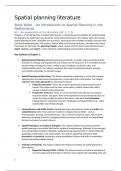Spatial planning literature
Book Witte – An Introduction to Spatial Planning in the
Netherlands
H1 – An exploration of the discipline (HC 1, 2, 3)
Chapter 1 of An Introduction to Spatial Planning lays a comprehensive foundation for understanding
the discipline by exploring its key academic and practical dimensions. The chapter opens by framing
spatial planning as both a discipline and a practice, focusing on how it bridges strategic concepts with
real-world implementation. The authors, Patrick Witte and Thomas Hartmann, introduce the central
framework for the book: the planning triangle, which consists of three interconnected dimensions—
object, process, and context—each critical for understanding and executing spatial planning.
Key Sections of Chapter 1:
1. Defining Spatial Planning: Spatial planning is presented as a public, future-oriented activity
that aims to manage and organize the use of space for the long term. It is not limited to land-
use planning or zoning but covers a wider scope of subjects, territorial scales, and
implementation tools. The authors emphasize the need for spatial planning to manage
uncertainties and adapt to societal changes.
2. Spatial Planning and the Future: The future orientation of planning is crucial. Since spatial
planning aims to shape future developments, it must deal with uncertainties. The chapter
highlights two main approaches to planning the future:
Projective Scenarios: These rely on past and present data to forecast future
trends. They often result in more conservative, realistic visions that reflect
current or historical developments.
Prospective Scenarios: These are more normative and visionary, focusing on
long-term desires and goals. They work backwards from an envisioned future to
create the steps needed to achieve that vision, with tools like backcasting
helping planners anticipate long-term challenges and opportunities (e.g., urban
sustainability and climate change).
3. Comprehensive and Public Activity: Spatial planning is described as inherently public and
comprehensive rather than sectoral. It seeks to integrate diverse fields—such as
transportation, housing, and environment—into a cohesive vision for space. This involves
balancing competing interests, managing limited resources (such as land), and negotiating
the best outcomes for public interest.
4. Spatial Planning as an Academic Discipline: The chapter explores the tension between
spatial planning as a practical field and its academic underpinnings. Although it has emerged
as an independent academic discipline, spatial planning draws heavily on related fields like
geography, public policy, and urban design. The authors argue that planning is both
theoretical and practical, requiring a strong foundation in theory but with an orientation
toward real-world problem solving.
5. Evolution of Planning: The chapter outlines the historical evolution of spatial planning in
three phases:
Blueprint Planning (1940s–1970s): This phase focused on technical and physical
reconstruction post-World War II. Planners were tasked with rebuilding cities and
1
, infrastructure, often using top-down, comprehensive plans to address clearly
defined spatial problems.
Collaborative Planning (1980s–1990s): The complexity of planning problems
increased, giving rise to a focus on process over the object of planning. This shift
emphasized stakeholder participation, communicative action, and collaborative
governance to address "wicked problems" that defied simple solutions.
Contextual Planning (2000s–present): More recent approaches to planning
emphasize the context in which planning occurs, understanding that processes
do not happen in a vacuum. External factors such as socio-economic trends,
political environments, and environmental challenges significantly influence
planning outcomes.
6. The Planning Triangle: The core analytical tool introduced in the chapter is the planning
triangle, which helps break down the three main dimensions of planning:
Object: The content of what is being planned (e.g., housing, infrastructure, or
mobility solutions). The chapter explains that conflicts often arise due to the
scarcity of land, and planners must make trade-offs between competing uses.
Process: How planning is carried out, including both formal and informal
mechanisms. The process involves interactions between stakeholders, public
participation, governance structures, and decision-making procedures.
Context: The external conditions under which planning occurs, such as societal
trends, economic conditions, political dynamics, and institutional frameworks.
Planners must be aware of how these contextual variables influence the success
of their interventions.
7. Tensions and Challenges: The chapter identifies several key tensions within spatial planning:
The balance between certainty and flexibility in planning decisions.
Navigating the trade-offs between different land uses, which often compete for
limited space.
Ensuring public participation without undermining the efficiency and
effectiveness of the planning process.
Managing the evolving nature of societal needs and expectations, which means
that planning is never truly "finished" but must constantly adapt.
Conclusion:
The chapter serves as an introduction to the broader discussion of spatial planning, setting the stage
for deeper explorations into each dimension of the planning triangle in the following chapters. The
planning triangle framework—object, process, and context—is presented as a way to systematically
understand the complex, interconnected aspects of spatial planning. The authors argue that
recognizing and managing the relationships between these dimensions is key to both the academic
study and practical execution of planning.
H2 – The object of planning: land-use (HC 4)
Chapter 2 of An Introduction to Spatial Planning focuses on the object of planning, which is primarily
land use. It introduces key characteristics of the object of planning, explores the relationship
between spatial and land-use planning, and analyzes land-use planning across various spatial scales.
The chapter also uses examples from Dutch planning practice to illustrate the complexity and scale of
land-use decisions.
Key Sections of Chapter 2:
2




